Tron Deadly Discs
 The Game: You are Tron, a lone video game warrior pitted against three other enemies with much greater armament. You can take a number of hits before you’re “de-rezzed” out of existence, but those hits can pile up pretty quickly. By throwing your disc at certain portions of the arena wall and changing them to the same color as your on-screen character, you can make tunnels for yourself – not unlike the side tunnels in Pac-Man – handy for escape or ambush. Every so often, however, a Recognizer will enter the arena, send out a force field to attempt to hold Tron immobile, and will close off those exits to restore the odds in favor of the house. If the Recognizer crushes Tron, that’ll end the game as quickly as letting the video warriors blast him repeatedly. (Mattel, 1982)
The Game: You are Tron, a lone video game warrior pitted against three other enemies with much greater armament. You can take a number of hits before you’re “de-rezzed” out of existence, but those hits can pile up pretty quickly. By throwing your disc at certain portions of the arena wall and changing them to the same color as your on-screen character, you can make tunnels for yourself – not unlike the side tunnels in Pac-Man – handy for escape or ambush. Every so often, however, a Recognizer will enter the arena, send out a force field to attempt to hold Tron immobile, and will close off those exits to restore the odds in favor of the house. If the Recognizer crushes Tron, that’ll end the game as quickly as letting the video warriors blast him repeatedly. (Mattel, 1982)
 Memories: Easily the most playable of the three Intellivision games based on Tron, Deadly Discs was also later ported to the Atari 2600, and despite the nice graphical bells and whistles bestowed upon this edition, it’s the 2600 version of the game which is most playable.
Memories: Easily the most playable of the three Intellivision games based on Tron, Deadly Discs was also later ported to the Atari 2600, and despite the nice graphical bells and whistles bestowed upon this edition, it’s the 2600 version of the game which is most playable.
Tron Solar Sailer
 The Game: In the third and final game of the trilogy of Intellivision games based on the movie Tron, you’re piloting the solar sailer vehicle stolen by Tron and Yori about 2/3 of the way through the movie. You ride the light beams through the digital realm, avoiding deadly (but dumb) grid bugs and pursuing Recognizers. You can fire weapons at both of the above, but doing this and keeping yourself on a clear path is the real challenge. (Mattel, 1982)
The Game: In the third and final game of the trilogy of Intellivision games based on the movie Tron, you’re piloting the solar sailer vehicle stolen by Tron and Yori about 2/3 of the way through the movie. You ride the light beams through the digital realm, avoiding deadly (but dumb) grid bugs and pursuing Recognizers. You can fire weapons at both of the above, but doing this and keeping yourself on a clear path is the real challenge. (Mattel, 1982)
Memories: Of any of the Tron games Mattel manufactured for its own Intellivision platform or the Atari 2600, Solar Sailer is probably the one which is most closely related to a scene in the movie. It may also be the hardest.
Tron Maze-a-Tron
 The Game: You are Flynn, the hero of the movie Tron. In phase one of the game, you navigate a maze of circuitry, avoiding Recognizers, and trying to, as the manual puts it, “gather zeroes to clear the RAM chips.” In phase two, you’re up against the Master Control Program itself, and you can beat it by matching pairs of numbers in the “bit stream” to pairs in the nearby “bit stack”…or something like that. (Mattel, 1982)
The Game: You are Flynn, the hero of the movie Tron. In phase one of the game, you navigate a maze of circuitry, avoiding Recognizers, and trying to, as the manual puts it, “gather zeroes to clear the RAM chips.” In phase two, you’re up against the Master Control Program itself, and you can beat it by matching pairs of numbers in the “bit stream” to pairs in the nearby “bit stack”…or something like that. (Mattel, 1982)
Memories: Maze-a-Tron never got around to impressing me. The rule book is thicker than I could imagine the program would be, and the needlessly complicated game play really doesn’t inspire me to come back for more. And in a way, it almost seems like a game that had little to do with Tron, but was barely similar enough that it merited the grafting-on of elements such as the MCP and the Recognizers from the movie, and voila, instant licensed product.
Tron Deadly Discs
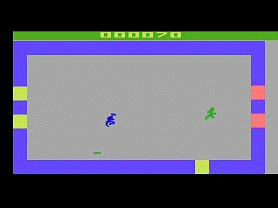 The Game: You are Tron, a lone video game warrior pitted against three other enemies with much greater armament. You can take a number of hits before you’re “de-rezzed” out of existence, but those hits can pile up pretty quickly. By throwing your disc at certain portions of the arena wall and changing them to the same color as your on-screen character, you can make tunnels for yourself – not unlike the side tunnels in Pac-Man – handy for escape or ambush. (M Network [Mattel], 1982)
The Game: You are Tron, a lone video game warrior pitted against three other enemies with much greater armament. You can take a number of hits before you’re “de-rezzed” out of existence, but those hits can pile up pretty quickly. By throwing your disc at certain portions of the arena wall and changing them to the same color as your on-screen character, you can make tunnels for yourself – not unlike the side tunnels in Pac-Man – handy for escape or ambush. (M Network [Mattel], 1982)
Memories: Though it only corresponds to a very brief scene in the movie Tron, Deadly Discs is a very addictive game – and quite a bit of fun, actually!
Threshold
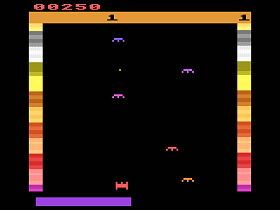 The Game: A lone space pilot is faced with the impossible task of fending off an entire alien invasion force single-handedly. Colliding with either the aliens or their decidedly unfriendly fire costs the player a ship. Clearing the screen of aliens only reveals a further wave of extraterrestrial killing machines. (Tigervision, 1982)
The Game: A lone space pilot is faced with the impossible task of fending off an entire alien invasion force single-handedly. Colliding with either the aliens or their decidedly unfriendly fire costs the player a ship. Clearing the screen of aliens only reveals a further wave of extraterrestrial killing machines. (Tigervision, 1982)
Memories: Tiger Electronics‘ entry into the increasingly crowded Atari VCS arena had a bit of an insurance policy: Tiger had made a deal with Sierra (then known as On-Line Systems) to port some of the company’s home computer hits to the console market. Threshold had a unique place in Sierra history: its programmer, Warren Schwader, was the company’s first employee from “outside the family” (all of the company’s previous products had been programmed by its founders, the husband-and-wife team of Ken and Roberta Williams).
SwordQuest: Earthworld
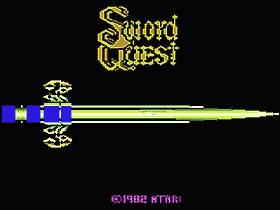
 The Game: As a lone adventurer, you wander through the labyrinthine expanses of an underground dungeon in search of a lost treasure. You must cross Frogger-esque screens of fast-moving logs, avoid rooms full of deadly spears which will only kill you just enough to drop-kick your sorry butt back to the bottom of the screen, and enjoy the full capabilities of the Atari 2600’s ability to generate varying frequencies of white noise. (Atari, 1982)
The Game: As a lone adventurer, you wander through the labyrinthine expanses of an underground dungeon in search of a lost treasure. You must cross Frogger-esque screens of fast-moving logs, avoid rooms full of deadly spears which will only kill you just enough to drop-kick your sorry butt back to the bottom of the screen, and enjoy the full capabilities of the Atari 2600’s ability to generate varying frequencies of white noise. (Atari, 1982)
Memories: One of the handful of debacles that marked the change in Atari‘s fortunes, the SwordQuest series was a very heavily-hyped four-game saga which tried to break new ground in the adventure genre for the 2600 console. Sadly, it didn’t even get close to breaking ground, or even wind for that matter – the fourth title, Airworld, was never released. Supposedly, the winners of each of the first three games would compete for a bejewelled prize and the opportunity to reconvene for a tournament to complete the fourth game first and win a wildly expensive sword.
Super Breakout
 The Game: You’ve got a mobile paddle and – well, frankly, balls. But you don’t have a lot of balls at your disposal (am I the only one becoming a little bit uncomfortable discussing this?), so you have to make the best use of them that you can to knock down the rows of colorful bricks overhead. In some games, there may be other, free-floating balls trapped in “cavities” in the bricks, and setting them loose will mean you’ll have several balls – and not all of them necessarily yours, disturbingly enough – to handle. Missing one of your balls – and we all know how painful that can be – forces you to call another ball into play. Losing all of your balls, as you’ve probably guessed by now, ends the game. So, in essence, Super Breakout is a metaphor for life from the masculine perspective. (Atari, 1982)
The Game: You’ve got a mobile paddle and – well, frankly, balls. But you don’t have a lot of balls at your disposal (am I the only one becoming a little bit uncomfortable discussing this?), so you have to make the best use of them that you can to knock down the rows of colorful bricks overhead. In some games, there may be other, free-floating balls trapped in “cavities” in the bricks, and setting them loose will mean you’ll have several balls – and not all of them necessarily yours, disturbingly enough – to handle. Missing one of your balls – and we all know how painful that can be – forces you to call another ball into play. Losing all of your balls, as you’ve probably guessed by now, ends the game. So, in essence, Super Breakout is a metaphor for life from the masculine perspective. (Atari, 1982)
Memories: So let’s see here. Atari had this great new console which sported, essentially, the guts of their Atari 400 computer, quite a bit of processing power (for its day) for a game-playing machine. Capable of detailed, colorful graphics and excellent sound effects, the Atari 5200 would, of course, need a fantastic pack-in title at launch, something which would showcase its amazing abilities. And that’s all fine and well, but what the poor 5200 wound up with was Super Breakout.
Sub Scan
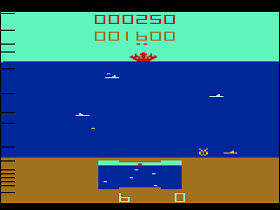 The Game: It’s a cold warrior’s nightmare! Enemy submarines glide silently through the seas below, but the only ordnance available isn’t of the guided variety. From a destroyer on the surface of the ocean, players have to carefully drop depth charges; taking out enemy subs will depend on timing and sheer luck. Failing to take out enemy subs – and wasting depth charges – will result in a deadly sinking feeling… (Sega, 1982)
The Game: It’s a cold warrior’s nightmare! Enemy submarines glide silently through the seas below, but the only ordnance available isn’t of the guided variety. From a destroyer on the surface of the ocean, players have to carefully drop depth charges; taking out enemy subs will depend on timing and sheer luck. Failing to take out enemy subs – and wasting depth charges – will result in a deadly sinking feeling… (Sega, 1982)
Memories: Sega‘s early attempts to break into the crowded Atari 2600 marketplace were a curious mixture of ports of the company’s arcade titles (Congo Bongo, Star Trek) and curious originals like Sub Scan, which didn’t originate in coin-op form. That’s not to say that Sub Scan has no arcade DNA, though – it’s an attempt to put a new spin on a classic quarter-grabber dating back to the ’70s.
Suicide Mission
 The Game: On a somewhat fantastic voyage into the human body, you’re in a tiny ship (presumably with Martin Short along for the ride) on a mission to blast diseased cells out of the bloodstream. Naturally, it’s not as easy a task as it sounds; the cells split into smaller cells when you zap them, and you have to clear even the tiniest remnants off the screen before advancing to the next treatment. (Arcadia, 1982)
The Game: On a somewhat fantastic voyage into the human body, you’re in a tiny ship (presumably with Martin Short along for the ride) on a mission to blast diseased cells out of the bloodstream. Naturally, it’s not as easy a task as it sounds; the cells split into smaller cells when you zap them, and you have to clear even the tiniest remnants off the screen before advancing to the next treatment. (Arcadia, 1982)
Memories: As with several of the earliest cassette-based games for the Supercharger add-on, Suicide Mission clearly owes a debt to an existing game that had already been released on the 2600. However, the prognosis is a bit grim here; this is a rare case where the game’s designers should made very sure that their game was an improvement on what came before. As both games suffer from severe sprite flicker, Asteroids comes out as the obvious winner here.
Star Voyager
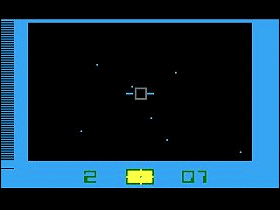 The Game: Patrolling the space lanes isn’t easy – ever noticed how many regions of space are teeming with hostile aliens? Your tour of duty aboard the Star Voyager is no different. Using a simple radar device for guidance, you have to track down alien ships and destroy them before they can return the favor. However, you have a limited energy reserve with which to accomplish this task. Alien hits on your ship will significantly deplete your energy, and firing your own lasers also gradually bleeds your ship dry. The only opportunity you have to replenish your energy is to defeat all the aliens within range and pass through a stargate. When you run out of energy, you’re out of luck. (Imagic, 1982)
The Game: Patrolling the space lanes isn’t easy – ever noticed how many regions of space are teeming with hostile aliens? Your tour of duty aboard the Star Voyager is no different. Using a simple radar device for guidance, you have to track down alien ships and destroy them before they can return the favor. However, you have a limited energy reserve with which to accomplish this task. Alien hits on your ship will significantly deplete your energy, and firing your own lasers also gradually bleeds your ship dry. The only opportunity you have to replenish your energy is to defeat all the aliens within range and pass through a stargate. When you run out of energy, you’re out of luck. (Imagic, 1982)
Memories: This fairly simple first-person space shoot ’em up – less complicated than either Star Raiders or Activision‘s Starmaster – was one of the best attempts of its era at a 3-D game on the 2600.
Star Raiders
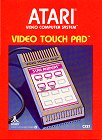
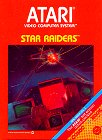
 The Game: Zylon warships are on the rampage, blasting allied basestars out of the sky and wreaking havoc throughout the galaxy. Your orders are to track down the fast-moving raiders and destroy them before they can do any more damage. You have limited shields and weapons at your disposal, and a battle computer which is vital to your mission (though critical damage to your space fighter can leave you without that rather important piece of equipment). The game is simple:
The Game: Zylon warships are on the rampage, blasting allied basestars out of the sky and wreaking havoc throughout the galaxy. Your orders are to track down the fast-moving raiders and destroy them before they can do any more damage. You have limited shields and weapons at your disposal, and a battle computer which is vital to your mission (though critical damage to your space fighter can leave you without that rather important piece of equipment). The game is simple:  destroy until you are destroyed, and defend friendly installations as long as you can. (Atari, 1982)
destroy until you are destroyed, and defend friendly installations as long as you can. (Atari, 1982)
Memories: A cult classic on the Atari 400 & 800 computers, Star Raiders was something that the VCS just couldn’t do.
Star Trek: The Motion Picture
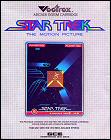 The Game: You’re at the helm of the U.S.S. Enterprise – that’s the cool part. The not-so-cool part? You’re in disputed territory – and the Klingons are bringing the fight to you en masse, attacking both the Enterprise and local Starbases, which you have the defend (lest you be left with no place to refuel). Use your phasers, photon torpedoes and shields judiciously – and do whatever it takes to halt the Klingon advance before they overrun Federation space. (GCE, 1982)
The Game: You’re at the helm of the U.S.S. Enterprise – that’s the cool part. The not-so-cool part? You’re in disputed territory – and the Klingons are bringing the fight to you en masse, attacking both the Enterprise and local Starbases, which you have the defend (lest you be left with no place to refuel). Use your phasers, photon torpedoes and shields judiciously – and do whatever it takes to halt the Klingon advance before they overrun Federation space. (GCE, 1982)
Memories: When the Enterprise returned by way of movie screens around the world in 1979, the sets and other visual details depicting the ship were brought right up to date to withstand big-screen scrutiny (and anticipated repeat viewing – though probably not even the movie’s makers knew to what degree that would be the case). The Enterprise’s onboard computers were shown to display, among other things, vector-graphics-style tactical displays – a fact not lost on the makers of the Vectrex console. Marrying the two was only – dare I say it? – logical.
Space Jockey
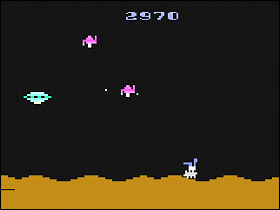 The Game: Space is a dangerous place, full of enemy fighters, hostile vehicles…and even enemy biplanes and enemy hot air balloons. Your job? Blow ’em all away. Your space fighter can hug the ground or zip into the stratosphere in a second, which is good because there are oncoming enemies at every altitude. If they take out all of your fighters, you might as well kiss the planet goodbye…which is kind of embarrassing if this means you’ve left the world open to invasion by balloon. (Vidtec [U.S. Games], 1982)
The Game: Space is a dangerous place, full of enemy fighters, hostile vehicles…and even enemy biplanes and enemy hot air balloons. Your job? Blow ’em all away. Your space fighter can hug the ground or zip into the stratosphere in a second, which is good because there are oncoming enemies at every altitude. If they take out all of your fighters, you might as well kiss the planet goodbye…which is kind of embarrassing if this means you’ve left the world open to invasion by balloon. (Vidtec [U.S. Games], 1982)
Memories: This is the first Atari game programmed by Garry Kitchen, who, after coding a VCS version of Donkey Kong for Coleco as a freelancer, would later join Activision. Space Jockey may not exactly be up to Activision’s specs, but it’s still an eminently playable variation on what was already a well-worn theme by its 1982 release.
Spy’s Demise (Apple II)
 The Game: Players control a spy sneaking through a building looking for secret information. High-speed elevators zoom up and down their cables throughout each floor at random intervals, making it difficult to accomplish the goal of crossing to the other side of the screen (the only way to ascend to the next floor). It takes skill, timing and nerves of steel to keep one’s spies from their demise. (Penguin Software, 1982)
The Game: Players control a spy sneaking through a building looking for secret information. High-speed elevators zoom up and down their cables throughout each floor at random intervals, making it difficult to accomplish the goal of crossing to the other side of the screen (the only way to ascend to the next floor). It takes skill, timing and nerves of steel to keep one’s spies from their demise. (Penguin Software, 1982)
Memories: An addictively fun and frustrating early entry on the Apple II computer, Alan Zeldin’s Spy’s Demise gave players some real elevator action.
Spider Fighter
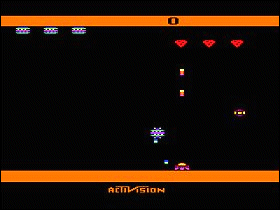
 The Game: It’s a full-scale infestation! Spiteful spiders are hatching everywhere you look, and they’ve got an eye on feeding and breeding. Your blaster is the only thing stopping them, and you’ve got to be lightning fast. (Activision, 1982)
The Game: It’s a full-scale infestation! Spiteful spiders are hatching everywhere you look, and they’ve got an eye on feeding and breeding. Your blaster is the only thing stopping them, and you’ve got to be lightning fast. (Activision, 1982)
Memories: Possibly the most original arcade-ish game Activision released for the Atari 2600, Spider Fighter is a fast and furious shoot-’em-up requiring a lot of fast thinking; it’s also refreshingly free of the flicker that plagues so many 2600 games.
Space Fury
 The Game: The Space Fury Commander – a big one-eyed dude with a veiny green cranium – challenges you to a duel. One slight problem: you’ve just got one ship and can only shoot in one direction at a time, and he has a whole battle fleet bent on your destruction. After surviving a round of his contest, you get the chance to dock with an enhancement module that will allow you to fire shots in several directions at once, or fire more powerful shots. The Commander always comes back to taunt you. When you lose all of your ships, the game is over, and one-eye gets to gloat. (Coleco [under license from Sega/Gremlin], 1982)
The Game: The Space Fury Commander – a big one-eyed dude with a veiny green cranium – challenges you to a duel. One slight problem: you’ve just got one ship and can only shoot in one direction at a time, and he has a whole battle fleet bent on your destruction. After surviving a round of his contest, you get the chance to dock with an enhancement module that will allow you to fire shots in several directions at once, or fire more powerful shots. The Commander always comes back to taunt you. When you lose all of your ships, the game is over, and one-eye gets to gloat. (Coleco [under license from Sega/Gremlin], 1982)
Memories: A better-than-decent adaptation of the cult arcade classic, Space Fury is that rare raster title that makes a virtue of having been adapted from an arcade game with a completely different graphics system. Space Fury spoke in the arcades with a robust speech synthesizer; ColecoVision Space Fury puts the Commander’s banter on the screen as a scrolling subtitle.
Spiders
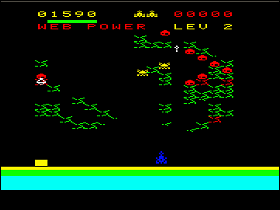 The Game: Spiders slink down from the top of the screen, constructing an elaborate web and laying eggs as they go. The player, manning a mobile bug-blasting cannon, can take out the spiders, but the eggs are still gestating and will hatch new spiders unless they’re destroyed; new spiders repeat the cycle in rapid succession. Spiders will manage to build their web to the bottom of the screen, restricting the cannon’s movement (and creating zones of the screen where future spider hatchlings can move unimpeded). The game ends when the player loses all of the cannons to the spiders or their incoming fire. (Emerson, 1982)
The Game: Spiders slink down from the top of the screen, constructing an elaborate web and laying eggs as they go. The player, manning a mobile bug-blasting cannon, can take out the spiders, but the eggs are still gestating and will hatch new spiders unless they’re destroyed; new spiders repeat the cycle in rapid succession. Spiders will manage to build their web to the bottom of the screen, restricting the cannon’s movement (and creating zones of the screen where future spider hatchlings can move unimpeded). The game ends when the player loses all of the cannons to the spiders or their incoming fire. (Emerson, 1982)
Memories: In this early epoch of the video game industry, there seemed to be a perception that you simply weren’t taking things seriously unless you secured an arcade license. Witness the Odyssey2, whose sole first-party licensed arcade port came too late in the machine’s library to bolster its popularity, or the Intellivision, which avoided arcade ports at first and then broke through to widespread popularity with a licensed home version of Burgertime.
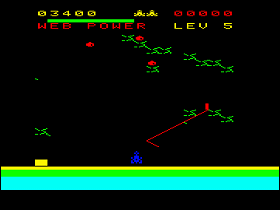 Not wanting to be a casualty of the video game wars, Emerson landed a handful of relatively obscure arcade licenses such as Jungler, Funky Fish and Spiders – none of them exactly household names in the coin-op world. (Most people probably can’t even remember seeing these games in the arcade at all; the author of this review barely remembers seeing Spiders and Jungler in the flesh.) Spiders was actually this vague and abstract in the arcade, too, so it’s really not a bad port, especially on the Arcadia 2001.
Not wanting to be a casualty of the video game wars, Emerson landed a handful of relatively obscure arcade licenses such as Jungler, Funky Fish and Spiders – none of them exactly household names in the coin-op world. (Most people probably can’t even remember seeing these games in the arcade at all; the author of this review barely remembers seeing Spiders and Jungler in the flesh.) Spiders was actually this vague and abstract in the arcade, too, so it’s really not a bad port, especially on the Arcadia 2001.
 For such an obscure arcade game, Spiders got around; there was also a fairly entertaining Entex tabletop game, though its matrix of fixed graphics made it much more difficult to figure out what was going on. The Arcadia version is fairly faithful to the original, duplicating the utter strangeness of the coin-op original nicely.
For such an obscure arcade game, Spiders got around; there was also a fairly entertaining Entex tabletop game, though its matrix of fixed graphics made it much more difficult to figure out what was going on. The Arcadia version is fairly faithful to the original, duplicating the utter strangeness of the coin-op original nicely.
Space Invaders
 The Game: You’re the pilot of a ground-based mobile weapons platform, and there are buttloads of alien meanies headed right for you. Your only defense is a trio of shields which are degraded by any weapons fire – yours or theirs – and a quick trigger finger. Occasionally a mothership zips across the top of the screen. When the screen is cleared of invaders, another wave – faster and more aggressive – appears. When you’re out of “lives,” or when the aliens manage to land on Earth… it’s all over. (Atari, 1982)
The Game: You’re the pilot of a ground-based mobile weapons platform, and there are buttloads of alien meanies headed right for you. Your only defense is a trio of shields which are degraded by any weapons fire – yours or theirs – and a quick trigger finger. Occasionally a mothership zips across the top of the screen. When the screen is cleared of invaders, another wave – faster and more aggressive – appears. When you’re out of “lives,” or when the aliens manage to land on Earth… it’s all over. (Atari, 1982)
Memories: Adapted from the Atari 400/800 home computer version of the coin-op hit, Space Invaders for the 5200 is certainly colorful, though one could argue that it’s ultimately not as faithful to the original as the graphically simpler version that appears on the Atari VCS.
Smurf: Rescue From Gargamel’s Castle
 The Game: You are an unidentified Smurf en route to save Smurfette from Gargamel’s castle. Now, you may think that Gargamel would deploy his vicious black cat to stop you from reaching that goal, but that sort
The Game: You are an unidentified Smurf en route to save Smurfette from Gargamel’s castle. Now, you may think that Gargamel would deploy his vicious black cat to stop you from reaching that goal, but that sort  of melodramatic stuff only happens in cartoons. Real Smurfs can be felled by something as innocuous as a fall off a very short ledge or running into clumps of grass. (Coleco, 1982)
of melodramatic stuff only happens in cartoons. Real Smurfs can be felled by something as innocuous as a fall off a very short ledge or running into clumps of grass. (Coleco, 1982)
Memories: The early 80s: video games were hot, new wave music was now mainstream, everybody who was anybody had given Rubik’s Cube a twist, and of course, there were Smurfs all over the place. Now, setting aside the fact that with the plural of knife being knives and the plural of scarf being scarves, the plural of Smurf should be Smurves, Peyo’s little blue critters were all over the place – cartoons, clothing, lunchboxes, toys, and more. You’d think that a market would have arisen for an effective Smurf repellant, perhaps in an environmentally-friendly non-aerosol spray form, but instead Coleco gave us this marvelous video game, in which those so inclined could send hundreds of the little pests hurtling headlong, lemming-like, to their death.
Smithereens!
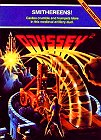 The Game: Armed with a catapult and a seemingly inexhaustible supply of projectiles (sorry, Python fans, no cows!), your task is to repeatedly and continuously smash your opponent’s castle, his catapult (rendering him harmless for a few seconds), or your opponent himself (much the same effect; a new enemy soldier enters the fray after a few seconds). (North American Philips, 1982)
The Game: Armed with a catapult and a seemingly inexhaustible supply of projectiles (sorry, Python fans, no cows!), your task is to repeatedly and continuously smash your opponent’s castle, his catapult (rendering him harmless for a few seconds), or your opponent himself (much the same effect; a new enemy soldier enters the fray after a few seconds). (North American Philips, 1982)
Memories: Possibly the best two-player Odyssey2 game there ever was, Smithereens! was exceedingly simple, and simply some of the best fun to be had on this game system.
SID The Spellbinder!
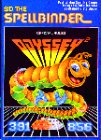 The Game: What happens when the Dreaded Dratapillar Of Venus makes a guest appearance? It means that a spelling bee is imminent! A friendly voice warns you to look out for a “monster attack,” and after dispatching all of the segments of the worm-like invader, you’re asked to correctly spell three words using the Odyssey2 keyboard. Once you’ve correctly spelled those three words, another monster attack occurs, with the Dratapillar moving faster in each successive level; the game continues until it descends far enough down the screen to reach your cannon. (North American Philips, 1982)
The Game: What happens when the Dreaded Dratapillar Of Venus makes a guest appearance? It means that a spelling bee is imminent! A friendly voice warns you to look out for a “monster attack,” and after dispatching all of the segments of the worm-like invader, you’re asked to correctly spell three words using the Odyssey2 keyboard. Once you’ve correctly spelled those three words, another monster attack occurs, with the Dratapillar moving faster in each successive level; the game continues until it descends far enough down the screen to reach your cannon. (North American Philips, 1982)
Memories: Programmed by Sam Overton, SID The Spellbinder! was one of the first two – and, as it so happened, only two – educational launch titles made available specifically for the then-new Voice Of Odyssey speech synthesizer.
Shark! Shark!
 The Game: Would you rather be a small fish in a small pond, or a big fish in a small pond? If you’re going to survive in this game, you’d better think big. Sharks and larger fish swim through the water, and if they’re bigger than you, you
The Game: Would you rather be a small fish in a small pond, or a big fish in a small pond? If you’re going to survive in this game, you’d better think big. Sharks and larger fish swim through the water, and if they’re bigger than you, you  have to avoid them or be eaten. You, on the other hand, can feed on smaller items which are below you on the food chain – and the more you eat, the more you grow, and this means you can eat more of the fish on the screen at any given time. But growth has its price: the bigger you get, the slower your fish becomes and the harder it is to get away from the shark. You can try to nibble the shark to death by biting his tail, but beware…he can bite back! (Mattel Electronics, 1982)
have to avoid them or be eaten. You, on the other hand, can feed on smaller items which are below you on the food chain – and the more you eat, the more you grow, and this means you can eat more of the fish on the screen at any given time. But growth has its price: the bigger you get, the slower your fish becomes and the harder it is to get away from the shark. You can try to nibble the shark to death by biting his tail, but beware…he can bite back! (Mattel Electronics, 1982)
Memories: One of the Intellivision’s more unique titles, Shark! Shark! is literally a cool little game about the food chain – and it’s an addictively fun one too, perfect for the whole family. The first time I set eyes on the game, I had no manual – and it took me the loss of just one of my fishy lives to suss out how it’s played. Of course, every so often one still gets a little too brave and drives the poor little fish right into some blatantly obvious hazard because it looked like it might be small enough to eat…
Room Of Doom
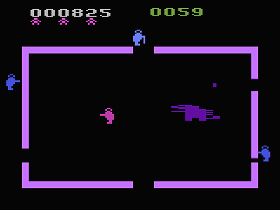 The Game: One man and one hideous mutant creature enter! A bunch of guys peek through holes in the walls and shoot at them! No one leaves! Room Of Doom turns the player into a gladiator, trapped in an enclosed arena with alien creatures. The rules are simple: kill or be killed. The only problem is that it’s always audience participation night: armed guards around the periphery of the arena will open doors at random and fire into the arena. With a well-timed shot before the doors slide shut, the player can do away with these extraneous attackers too. Only by eliminating all of the guards can the player advance to the next level. (Commavid, 1982)
The Game: One man and one hideous mutant creature enter! A bunch of guys peek through holes in the walls and shoot at them! No one leaves! Room Of Doom turns the player into a gladiator, trapped in an enclosed arena with alien creatures. The rules are simple: kill or be killed. The only problem is that it’s always audience participation night: armed guards around the periphery of the arena will open doors at random and fire into the arena. With a well-timed shot before the doors slide shut, the player can do away with these extraneous attackers too. Only by eliminating all of the guards can the player advance to the next level. (Commavid, 1982)
Memories: One of those games that doesn’t exactly look sophisticated but is actually kind of addictive, Room Of Doom was heavily promoted by Commavid back in the day by way of an extensive print advertising campaign in the major video game magazines. Those print ads concentrated more on the stylized packaging artwork than the game graphics themselves, which was probably wise, but Room Of Doom is no slouch when it comes to pure fun.
River Raid
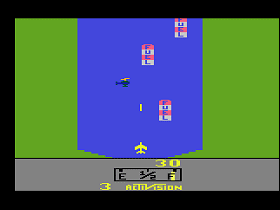
 The Game: You’re piloting a fighter jet on a canyon run through enemy territory. You can’t fly outside the canyon walls, so stay over the river and blast everything in sight. Well, almost everything – flying your plane on top of “FUEL” buoys instead of shooting them puts a little bit of gas in the tank, and if you run out of fuel, you might as well just swallow the next enemy bullet, because you’re goin’ down. (Activision, 1982)
The Game: You’re piloting a fighter jet on a canyon run through enemy territory. You can’t fly outside the canyon walls, so stay over the river and blast everything in sight. Well, almost everything – flying your plane on top of “FUEL” buoys instead of shooting them puts a little bit of gas in the tank, and if you run out of fuel, you might as well just swallow the next enemy bullet, because you’re goin’ down. (Activision, 1982)
Memories: As you advance through the levels and it gets more challenging, River Raid becomes the same kind of balancing act between self-preservation and going on the offensive that is a hallmark of all-time classics like Robotron. River Raid was the brainchild of Activision programmer Carol Shaw, one of the small number of women who had a vital hand in the early video game industry (such as Carla Meninsky, programmer of numerous early Atari 2600 titles, and Dona Bailey, an Atari arcade programmer who co-designed Centipede). And yet River Raid is a shoot-’em’-up that’ll challenge any hardcore joystick jock.
Shark Attack
 The Game: You’re a deep-sea diver in search of treasure under the ocean. There are only a couple of problems though – there’s a maze made of messy seaweed, which can slow you down or even trap you until you work your way free of it. And if that’s not enough of a problem, these waters are shark-infested, meaning that getting stuck in the path of a finned foe could mean your finish. (Games By Apollo, 1982)
The Game: You’re a deep-sea diver in search of treasure under the ocean. There are only a couple of problems though – there’s a maze made of messy seaweed, which can slow you down or even trap you until you work your way free of it. And if that’s not enough of a problem, these waters are shark-infested, meaning that getting stuck in the path of a finned foe could mean your finish. (Games By Apollo, 1982)
Memories: A very thinly-disguised Pac-Man ripoff (the “treasures” are just dots, need I say more?), Shark Attack‘s storied history is more interesting than the game itself.
Reactor
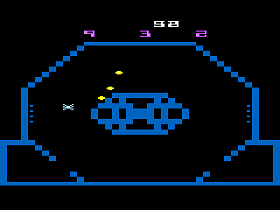 The Game: In a bizarre combination of pinball, zero gravity, and nuclear physics, you pilot your “ship” around a reactor chamber, trying to eliminate rogue radioactive particles (which are about the same size as your ship). Anything touching the outer walls of the chamber will be destroyed, including your on-screen alter ego. Two pairs of five rods can be used to cool down the ever-expanding nuclear reaction at the center of the screen, but you can only push the rods in by bumping the particle into them head-on. Trapping particles in either of two cul-de-sacs in the upper right and lower left corners of the playing field will earn you bonus points, and the best way to accomplish this is to plant one of your limited number of decoys at the entrance to one of the smaller areas. In early levels, you can keep your back to the reactor and hug it as you bounce the particles off of it, but in later levels, the reactions are exposed and become just as deadly to you as to the walls are. (Parker Brothers, 1982)
The Game: In a bizarre combination of pinball, zero gravity, and nuclear physics, you pilot your “ship” around a reactor chamber, trying to eliminate rogue radioactive particles (which are about the same size as your ship). Anything touching the outer walls of the chamber will be destroyed, including your on-screen alter ego. Two pairs of five rods can be used to cool down the ever-expanding nuclear reaction at the center of the screen, but you can only push the rods in by bumping the particle into them head-on. Trapping particles in either of two cul-de-sacs in the upper right and lower left corners of the playing field will earn you bonus points, and the best way to accomplish this is to plant one of your limited number of decoys at the entrance to one of the smaller areas. In early levels, you can keep your back to the reactor and hug it as you bounce the particles off of it, but in later levels, the reactions are exposed and become just as deadly to you as to the walls are. (Parker Brothers, 1982)
Memories: A game attempt at translating Gottlieb‘s sleeper hit coin-op, Reactor for the Atari 2600 may lose some of its first audiovisual grain in the translation, but it’s still Reactor – well, kinda. The rockin’ music is mangled (though I have to give the programmers of the 2600 port some points for the effort of even trying to mimic it), and its free-roaming action was never intended to be confined to the clumsy control of a joystick. (Though after playing Reactor with the Wico Command Control trakball, I still have to say that this is a long way off from playing Reactor in the arcade with a trakball.)
Raiders Of The Lost Ark
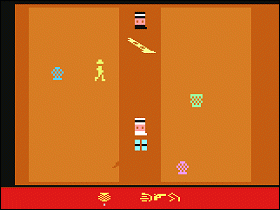 The Game: You’re guiding a pixellated rendition of famed adventurer Indiana Jones as he embarks on his search for the Lost Ark of the Covenant. Meander through Middle Eastern marketplaces, obtain weapons and items of value, and watch out for snakes as you try to overcome a series of obstacles and hazardous environments, find the clues, and recover the Ark. (Atari, 1982)
The Game: You’re guiding a pixellated rendition of famed adventurer Indiana Jones as he embarks on his search for the Lost Ark of the Covenant. Meander through Middle Eastern marketplaces, obtain weapons and items of value, and watch out for snakes as you try to overcome a series of obstacles and hazardous environments, find the clues, and recover the Ark. (Atari, 1982)
Memories: One of the two movie licenses that landed on programmer Howard Scott Warshaw’s desk, the Atari 2600 game Raiders Of The Lost Ark is a near-perfect specimen of an adventure game on this console: it makes sense from reading the manual, but in practice, the way in which the game’s various settings and characters interlock and interact is almost abstract. Maybe this is one of those games where I’m just not getting the point, but I’ve always wondered why E.T. is held up as an example of what not to do with a 2600 game, and Raiders is held up as an example of a great game – to me, they’re almost identical.
Ram It!
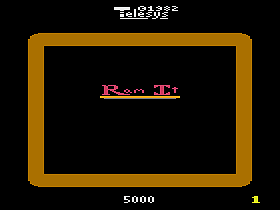 The Game: Controlling the on-screen “ramroid,” you’re up against what appears to be a malevolent bar graph. Your job is to keep the colorful bars from reaching the center of the screen from the left and right sides of the playing field; once they reach the center, you can’t eliminate them unless you’re playing a game variation where they might randomly become flashing “bonus” bars that can be eliminated with a single shot. If two bars meet at the center of the screen, they form an inpenetrable barrier that traps you above or below them. A round ends when the timer runs out (it counts down from 5000), when you’ve eliminated the last oncoming bar from the screen that you can reach, or – preferably – when you completely clear the screen of those bars. (Telesys, 1982)
The Game: Controlling the on-screen “ramroid,” you’re up against what appears to be a malevolent bar graph. Your job is to keep the colorful bars from reaching the center of the screen from the left and right sides of the playing field; once they reach the center, you can’t eliminate them unless you’re playing a game variation where they might randomly become flashing “bonus” bars that can be eliminated with a single shot. If two bars meet at the center of the screen, they form an inpenetrable barrier that traps you above or below them. A round ends when the timer runs out (it counts down from 5000), when you’ve eliminated the last oncoming bar from the screen that you can reach, or – preferably – when you completely clear the screen of those bars. (Telesys, 1982)
Memories: This is a game that shouldn’t work in terms of being entertaining, but it does. This is a game that, by 1982, was certainly graphically behind the times, but it still works. Ram It! is a seemingly simple game that is nothing short of a maddening addiction for me – I’m always compelled to hit the reset switch again, to try and do better one more time. Perhaps the best description of it would be “Breakout from both ends,” but that just sounds wrong somehow.
Racquetball
 The Game: One or two players try to keep a ball in motion in an enclosed space; standard racquetball rules apply. (Games By Apollo, 1982)
The Game: One or two players try to keep a ball in motion in an enclosed space; standard racquetball rules apply. (Games By Apollo, 1982)
Memories: As discussed earlier in our review of Skeet Shoot, Games By Apollo was the first third-party game software supplier for the Atari 2600 founded by a speculator with no prior ties to the video game industry. Skeet Shoot, Apollo’s first game, was rushed out as quickly as possible, whereas programmer Ed Salvo had a little more time to roll out Racquetball, and the graphical difference is huge.
Qix
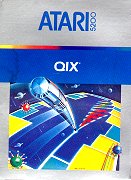 The Game: You control a “marker,” trying to claim as much of the playing field as you can by enclosing areas of it. Drawing your boundaries faster is safer, but yields fewer points. A slower draw, which leaves you vulnerable to attack from the Qix and the Sparx, gives you many more points upon the completion of an enclosed area. If the ever-shifting Qix touches your marker or an uncompleted boundary you are drawing, you lose a “life” and start again. And the Sparx, which travel only along the edges of the playing field and along the boundaries of areas of the screen you’ve already enclosed, can destroy you by touching your marker. And if you linger too long, a fuse will begin burning at the beginning of your unfinished boundary, and will eventually catch up with you. (Atari, 1982)
The Game: You control a “marker,” trying to claim as much of the playing field as you can by enclosing areas of it. Drawing your boundaries faster is safer, but yields fewer points. A slower draw, which leaves you vulnerable to attack from the Qix and the Sparx, gives you many more points upon the completion of an enclosed area. If the ever-shifting Qix touches your marker or an uncompleted boundary you are drawing, you lose a “life” and start again. And the Sparx, which travel only along the edges of the playing field and along the boundaries of areas of the screen you’ve already enclosed, can destroy you by touching your marker. And if you linger too long, a fuse will begin burning at the beginning of your unfinished boundary, and will eventually catch up with you. (Atari, 1982)
Memories: One can think of no better early 80s platform for Qix than the Atari 5200, and it almost manages to pull off a perfect translation. Qix is another case where the infamous 5200 joysticks can confound your efforts to draw a straight line, but a lot of games have that problem, and I can’t really hold the grudge against anyone but whoever it was who designed those controllers.